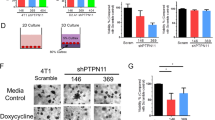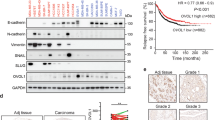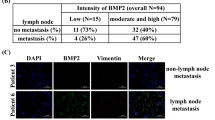Abstract
Transforming growth factor (TGF)-β can suppress and promote breast cancer progression. How TGF-β elicits these dichotomous functions and which roles the principle intracellular effector proteins Smad2 and Smad3 have therein, is unclear. Here, we investigated the specific functions of Smad2 and Smad3 in TGF-β-induced responses in breast cancer cells in vitro and in a mouse model for breast cancer metastasis. We stably knocked down Smad2 or Smad3 expression in MDA-MB-231 breast cancer cells. The TGF-β-induced Smad3-mediated transcriptional response was mitigated and enhanced by Smad3 and Smad2 knockdown, respectively. This response was also seen for TGF-β-induced vascular endothelial growth factor (VEGF) expression. TGF-β induction of key target genes involved in bone metastasis, were found to be dependent on Smad3 but not Smad2. Strikingly, whereas knockdown of Smad3 in MDA-MB-231 resulted in prolonged latency and delayed growth of bone metastasis, Smad2 knockdown resulted in a more aggressive phenotype compared with control MDA-MB-231 cells. Consistent with differential effects of Smad knockdown on TGF-β-induced VEGF expression, these opposing effects of Smad2 versus Smad3 could be directly correlated with divergence in the regulation of tumor angiogenesis in vivo. Thus, Smad2 and Smad3 differentially affect breast cancer bone metastasis formation in vivo.
This is a preview of subscription content, access via your institution
Access options
Subscribe to this journal
Receive 50 print issues and online access
$259.00 per year
only $5.18 per issue
Buy this article
- Purchase on Springer Link
- Instant access to full article PDF
Prices may be subject to local taxes which are calculated during checkout






Similar content being viewed by others
Abbreviations
- ALK:
-
activin receptor-like kinase
- BLI:
-
bioluminescent imaging
- BMP:
-
bone morphogenetic protein
- CTGF:
-
connective tissue growth factor
- EMT:
-
epithelial to mesenchymal transition
- GFP:
-
green fluorescent protein
- HIF-1α:
-
hypoxia inducible factor-1α
- IL-11:
-
interleukin 11
- miR RNAi:
-
micro RNA interference
- MH:
-
Mad homology
- N-T control:
-
non-targeting control
- PAI-1:
-
plasminogen activator inhibitor-1
- PlGF:
-
placenta growth factor
- PTHrP:
-
parathyroid hormone-related protein
- P-Smad:
-
phosphorylated Smad
- R-Smad:
-
receptor-regulated Smad
- Smad:
-
small phenotype and mothers against decapentaplegic related protein
- TGF-β:
-
transforming growth factor-β
- TβRII:
-
TGF-β type II receptor
- VEGF:
-
vascular endothelial growth factor
References
Ashcroft GS, Yang X, Glick AB, Weinstein M, Letterio JL, Mizel DE et al. (1999). Mice lacking Smad3 show accelerated wound healing and an impaired local inflammatory response. Nat Cell Biol 1: 260–266.
Bruna A, Darken RS, Rojo F, Ocana A, Penuelas S, Arias A et al. (2007). High TGFbeta-Smad activity confers poor prognosis in glioma patients and promotes cell proliferation depending on the methylation of the PDGF-B gene. Cancer Cell 11: 147–160.
Buijs JT, Henriquez NV, van Overveld PG, van der Horst G, ten Dijke P, van der Pluijm G . (2007b). TGF-β and BMP7 interactions in tumour progression and bone metastasis. Clin Exp Metastasis 24: 609–617.
Buijs JT, Henriquez NV, van Overveld PG, van der Horst G, Que I, Schwaninger R et al. (2007a). Bone morphogenetic protein 7 in the development and treatment of bone metastases from breast cancer. Cancer Res 67: 8742–8751.
Buijs JT, van der Pluijm G . (2009). Osteotropic cancers: from primary tumor to bone. Cancer Lett 273: 177–193.
Burdette JE, Jeruss JS, Kurley SJ, Lee EJ, Woodruff TK . (2005). Activin A mediates growth inhibition and cell cycle arrest through Smads in human breast cancer cells. Cancer Res 65: 7968–7975.
Deckers M, van Dinther M, Buijs J, Que I, Lowik C, van der Pluijm G et al. (2006). The tumor suppressor Smad4 is required for transforming growth factor beta-induced epithelial to mesenchymal transition and bone metastasis of breast cancer cells. Cancer Res 66: 2202–2209.
Dennler S, Huet S, Gauthier JM . (1999). A short amino-acid sequence in MH1 domain is responsible for functional differences between Smad2 and Smad3. Oncogene 18: 1643–1648.
Desruisseau S, Palmari J, Giusti C, Romain S, Martin PM, Berthois Y . (2006). Determination of TGFbeta1 protein level in human primary breast cancers and its relationship with survival. Br J Cancer 94: 239–246.
Donovan D, Harmey JH, Toomey D, Osborne DH, Redmond HP, Bouchier-Hayes DJ . (1997). TGF beta-1 regulation of VEGF production by breast cancer cells. Ann Surg Oncol 4: 621–627.
Dzwonek J, Preobrazhenska O, Cazzola S, Conidi A, Schellens A, van Dinther M et al. (2009). Smad3 is a key nonredundant mediator of transforming growth factor beta signaling in Nme mouse mammary epithelial cells. Mol Cancer Res 7: 1342–1353.
Ebos JM, Lee CR, Cruz-Munoz W, Bjarnason GA, Christensen JG, Kerbel RS . (2009). Accelerated metastasis after short-term treatment with a potent inhibitor of tumor angiogenesis. Cancer Cell 15: 232–239.
Ehata S, Hanyu A, Fujime M, Katsuno Y, Fukunaga E, Goto K et al. (2007). Ki26894, a novel transforming growth factor-β type I receptor kinase inhibitor, inhibits in vitro invasion and in vivo bone metastasis of a human breast cancer cell line. Cancer Sci 98: 127–133.
Ge R, Rajeev V, Ray P, Lattime E, Rittling S, Medicherla S et al. (2006). Inhibition of growth and metastasis of mouse mammary carcinoma by selective inhibitor of transforming growth factor-β type I receptor kinase in vivo. Clin Cancer Res 12: 4315–4330.
Ghellal A, Li C, Hayes M, Byrne G, Bundred N, Kumar S . (2000). Prognostic significance of TGF beta 1 and TGF beta 3 in human breast carcinoma. Anticancer Res 20: 4413–4418.
Heffelfinger SC, Miller MA, Yassin R, Gear R . (1999). Angiogenic growth factors in preinvasive breast disease. Clin Cancer Res 5: 2867–2876.
Hoot KE, Lighthall J, Han G, Lu SL, Li A, Ju W et al. (2008). Keratinocyte-specific Smad2 ablation results in increased epithelial-mesenchymal transition during skin cancer formation and progression. J Clin Invest 118: 2722–2732.
Isogai C, Laug WE, Shimada H, Declerck PJ, Stins MF, Durden DL et al. (2001). Plasminogen activator inhibitor-1 promotes angiogenesis by stimulating endothelial cell migration toward fibronectin. Cancer Res 61: 5587–5594.
Ivanovic V, Todorovic-Rakovic N, Demajo M, Neskovic-Konstantinovic Z, Subota V, Ivanisevic-Milovanovic O et al. (2003). Elevated plasma levels of transforming growth factor-β 1 (TGF-β1) in patients with advanced breast cancer: association with disease progression. Eur J Cancer 39: 454–461.
Kang Y, He W, Tulley S, Gupta GP, Serganova I, Chen CR et al. (2005). Breast cancer bone metastasis mediated by the Smad tumor suppressor pathway. Proc Natl Acad Sci USA 102: 13909–13914.
Kang Y, Siegel PM, Shu W, Drobnjak M, Kakonen SM, Cordon-Cardo C et al. (2003). A multigenic program mediating breast cancer metastasis to bone. Cancer Cell 3: 537–549.
Kingsley LA, Fournier PG, Chirgwin JM, Guise TA . (2007). Molecular biology of bone metastasis. Mol Cancer Ther 6: 2609–2617.
Kirkbride KC, Blobe GC . (2003). Inhibiting the TGF-β signalling pathway as a means of cancer immunotherapy. Expert Opin Biol Ther 3: 251–261.
Kobayashi T, Liu X, Wen FQ, Fang Q, Abe S, Wang XQ et al. (2005). Smad3 mediates TGF-β1 induction of VEGF production in lung fibroblasts. Biochem Biophys Res Commun 327: 393–398.
Kretschmer A, Moepert K, Dames S, Sternberger M, Kaufmann J, Klippel A . (2003). Differential regulation of TGF-β signaling through Smad2, Smad3 and Smad4. Oncogene 22: 6748–6763.
LaGamba D, Nawshad A, Hay ED . (2005). Microarray analysis of gene expression during epithelial-mesenchymal transformation. Dev Dyn 234: 132–142.
Leivonen SK, Kahari VM . (2007). Transforming growth factor-beta signaling in cancer invasion and metastasis. Int J Cancer 121: 2119–2124.
Massague J . (2008). TGFbeta in Cancer. Cell 134: 215–230.
Massague J, Seoane J, Wotton D . (2005). Smad transcription factors. Genes Dev 19: 2783–2810.
Matsui J, Funahashi Y, Uenaka T, Watanabe T, Tsuruoka A, Asada M . (2008). Multi-kinase inhibitor E7080 suppresses lymph node and lung metastases of human mammary breast tumor MDA-MB-231 via inhibition of vascular endothelial growth factor-receptor (VEGF-R) 2 and VEGF-R3 kinase. Clin Cancer Res 14: 5459–5465.
McEarchern JA, Kobie JJ, Mack V, Wu RS, Meade-Tollin L, Arteaga CL et al. (2001). Invasion and metastasis of a mammary tumor involves TGF-β signaling. Int J Cancer 91: 76–82.
Moustakas A, Heldin CH . (2007). Signaling networks guiding epithelial-mesenchymal transitions during embryogenesis and cancer progression. Cancer Sci 98: 1512–1520.
Muraoka RS, Dumont N, Ritter CA, Dugger TC, Brantley DM, Chen J et al. (2002). Blockade of TGF-β inhibits mammary tumor cell viability, migration, and metastases. J Clin Invest 109: 1551–1559.
Nakagawa T, Li JH, Garcia G, Mu W, Piek E, Bottinger EP et al. (2004). TGF-β induces proangiogenic and antiangiogenic factors via parallel but distinct Smad pathways. Kidney Int 66: 605–613.
Nam JS, Terabe M, Mamura M, Kang MJ, Chae H, Stuelten C et al. (2008). An anti-transforming growth factor beta antibody suppresses metastasis via cooperative effects on multiple cell compartments. Cancer Res 68: 3835–3843.
Nawshad A, LaGamba D, Polad A, Hay ED . (2005). Transforming growth factor-β signaling during epithelial-mesenchymal transformation: implications for embryogenesis and tumor metastasis. Cells Tissues Organs 179: 11–23.
Oft M, Akhurst RJ, Balmain A . (2002). Metastasis is driven by sequential elevation of H-ras and Smad2 levels. Nat Cell Biol 4: 487–494.
Paez-Ribes M, Allen E, Hudock J, Takeda T, Okuyama H, Vinals F et al. (2009). Antiangiogenic therapy elicits malignant progression of tumors to increased local invasion and distant metastasis. Cancer Cell 15: 220–231.
Petersen M, Thorikay M, Deckers M, van Dinther M, Grygielko ET, Gellibert F et al. (2008). Oral administration of GW788388, an inhibitor of TGF-β type I and II receptor kinases, decreases renal fibrosis. Kidney Int 73: 705–715.
Sanchez-Elsner T, Botella LM, Velasco B, Corbi A, Attisano L, Bernabeu C . (2001). Synergistic cooperation between hypoxia and transforming growth factor-β pathways on human vascular endothelial growth factor gene expression. J Biol Chem 276: 38527–38535.
Schmierer B, Hill CS . (2007). TGFbeta-SMAD signal transduction: molecular specificity and functional flexibility. Nat Rev Mol Cell Biol 8: 970–982.
Sheen-Chen SM, Chen HS, Sheen CW, Eng HL, Chen WJ . (2001). Serum levels of transforming growth factor beta1 in patients with breast cancer. Arch Surg 136: 937–940.
Tannehill-Gregg SH, Kusewitt DF, Rosol TJ, Weinstein M . (2004). The roles of Smad2 and Smad3 in the development of chemically induced skin tumors in mice. Vet Pathol 41: 278–282.
ten Dijke P, Hill CS . (2004). New insights into TGF-β-Smad signalling. Trends Biochem Sci 29: 265–273.
Tian F, Byfield SD, Parks WT, Stuelten CH, Nemani D, Zhang YE et al. (2004). Smad-binding defective mutant of transforming growth factor beta type I receptor enhances tumorigenesis but suppresses metastasis of breast cancer cell lines. Cancer Res 64: 4523–4530.
Tian F, DaCosta BS, Parks WT, Yoo S, Felici A, Tang B et al. (2003). Reduction in Smad2/3 signaling enhances tumorigenesis but suppresses metastasis of breast cancer cell lines. Cancer Res 63: 8284–8292.
van der Pluijm G, Sijmons B, Vloedgraven H, Deckers M, Papapoulos S, Lowik C . (2001). Monitoring metastatic behavior of human tumor cells in mice with species-specific polymerase chain reaction: elevated expression of angiogenesis and bone resorption stimulators by breast cancer in bone metastases. J Bone Miner Res 16: 1077–1091.
Weinstein M, Yang X, Li C, Xu X, Gotay J, Deng CX . (1998). Failure of egg cylinder elongation and mesoderm induction in mouse embryos lacking the tumor suppressor Smad2. Proc Natl Acad Sci USA 95: 9378–9383.
Xie W, Mertens JC, Reiss DJ, Rimm DL, Camp RL, Haffty BG et al. (2002). Alterations of Smad signaling in human breast carcinoma are associated with poor outcome: a tissue microarray study. Cancer Res 62: 497–505.
Yang X, Letterio JJ, Lechleider RJ, Chen L, Hayman R, Gu H et al. (1999). Targeted disruption of SMAD3 results in impaired mucosal immunity and diminished T cell responsiveness to TGF-β. EMBO J 18: 1280–1291.
Yin JJ, Selander K, Chirgwin JM, Dallas M, Grubbs BG, Wieser R et al. (1999). TGF-β signaling blockade inhibits PTHrP secretion by breast cancer cells and bone metastases development. J Clin Invest 103: 197–206.
Acknowledgements
We thank Martine Deckers and Maarten van Dinther for their initial studies and members of our research group for help and suggestions during the course of this work. We are grateful to Lukas Hawinkels and Hein Verspaget for assistance with VEGF ELISA measurements, Kuber Sampath (Genzyme) for BMP6, Ken Iwata (OSI Pharmaceuticals) for TGF-β3 and Dr Philippe Clézardin for the MDA-MB-231 subclone BO2. This work was supported by the Dutch Cancer Society (UL 2005–3371), Ludwig Institute for Cancer Research and grants from the Sixth European Union Framework Programme, that is, the EpiplastCarcinoma Marie Curie RTN (project 005428), Angiotargeting (project 504743), BRECOSM (project 503224) and Tumor-Host Genomics (project 518198).
Author information
Authors and Affiliations
Corresponding author
Additional information
Supplementary Information accompanies the paper on the Oncogene website (http://www.nature.com/onc)
Supplementary information
Rights and permissions
About this article
Cite this article
Petersen, M., Pardali, E., van der Horst, G. et al. Smad2 and Smad3 have opposing roles in breast cancer bone metastasis by differentially affecting tumor angiogenesis. Oncogene 29, 1351–1361 (2010). https://doi.org/10.1038/onc.2009.426
Received:
Revised:
Accepted:
Published:
Issue Date:
DOI: https://doi.org/10.1038/onc.2009.426
Keywords
This article is cited by
-
Deep learning for de-convolution of Smad2 versus Smad3 binding sites
BMC Genomics (2022)
-
Long noncoding RNA Smyca coactivates TGF-β/Smad and Myc pathways to drive tumor progression
Journal of Hematology & Oncology (2022)
-
Matriptase-2/NR4A3 axis switches TGF-β action toward suppression of prostate cancer cell invasion, tumor growth, and metastasis
Oncogene (2022)
-
SMAD2/3 mediate oncogenic effects of TGF-β in the absence of SMAD4
Communications Biology (2022)
-
Expression of CCL2/CCR2 signaling proteins in breast carcinoma cells is associated with invasive progression
Scientific Reports (2021)



